Intersections: Ski Racing and Photography; Final Thoughts, Part 9
It’s June 28 and the skiable, raceable snow has melted here. So our race season is now long over and it’s time to leave race photography behind for a few months. This final post in the Intersections series ends with my personal pick for my best race photo of the 2020-2021 season, and explains my (idiosyncratic) reasons for choosing it.
But first, it is worth acknowledging there are riskier ways to photograph alpine races that can produce exceptional and high-quality images. Nonetheless, photographers trying to produce high quality photos of every racer in every race in every run (or at least every run they photograph) need consistency. They can’t risk settings or gear choices that might not work for each racer and that wouldn’t produce good images of every racer or result in good choices to submit to media outlets.
Now and then I can take a few chances, but not often. Here's a mid-race exception.
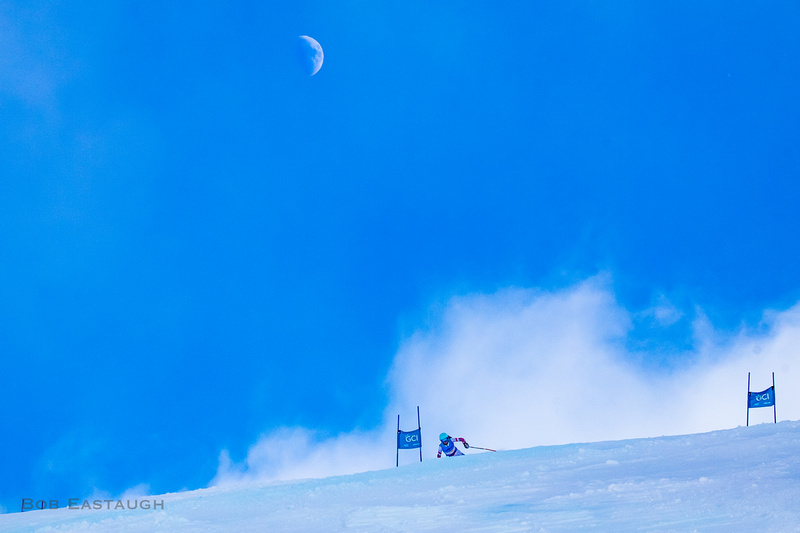

This image worked for one racer, but at some risk of missing others. This is, by the way, one of my recent favorites, but the emphasis is on the scene, not the racer. And unless you knew her race suit, helmet color, or bib number, you would have a hard time identifying her. The moon was shot as is, by the way. This is not a Photoshopped image.
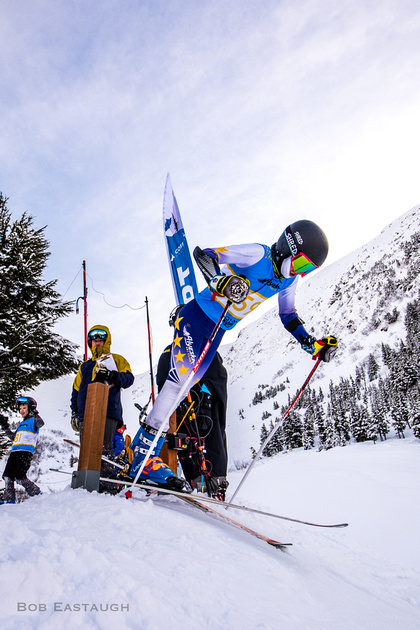

And this photo, taken with a very wide-angle lens (16mm), worked here, but this equipment choice makes it hard to cover everyone. An ultra-wide lens is effectively a one-gate lens, and requires being so close that it only works safely in the start gate.
Media likes exceptional images, not just stereotypical gate-crush photos. Everyone does. And someone only working toward publication of a very few images could take a riskier approach. Taking 5,000 high-risk shots will probably result in at least ten really good shots. But even though using a very wide or a very long lens might pay off with a few exceptional photos, that will not work consistently for most of the field on race day. Light permitting, a zoom lens provides more flexibility and range, from relatively distant to relatively close, i.e., at least three gates and sometimes five or six, depending on the event and course set and shooting conditions.
This also, unfortunately, usually rules out slow-shutter speed panning (moving the camera to track the racer while pressing the shutter button) even though it can depict speed better. Shutter speeds slow enough to blur the background also make it much more likely the racer's image will not be sharp, or sharp enough (they aren’t quite the same thing). A very slow shutter speed can produce a nice, arty image of a racer, but a very high percentage won’t be sharp. Most racers don’t want to be depicted as unsharp. Here are a few examples from past years. One was taken during training, when I wasn’t trying to produce a photo of a contender sharp enough for publication and wasn’t trying to get uploadable photos of everyone. There are some race photos, too, because on multi-run, multi-race days, I can take some risks now and then. But only one of these was really sharp; the others may look sharp when small, but lose quality at bigger sizes.


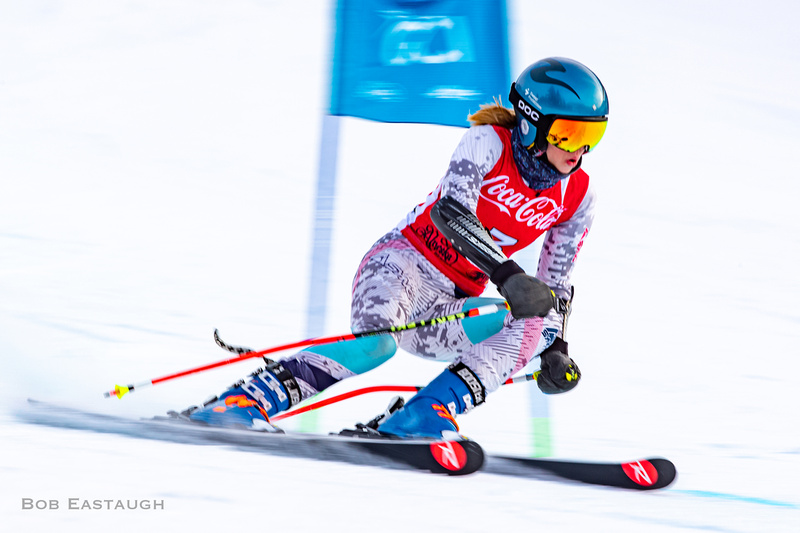

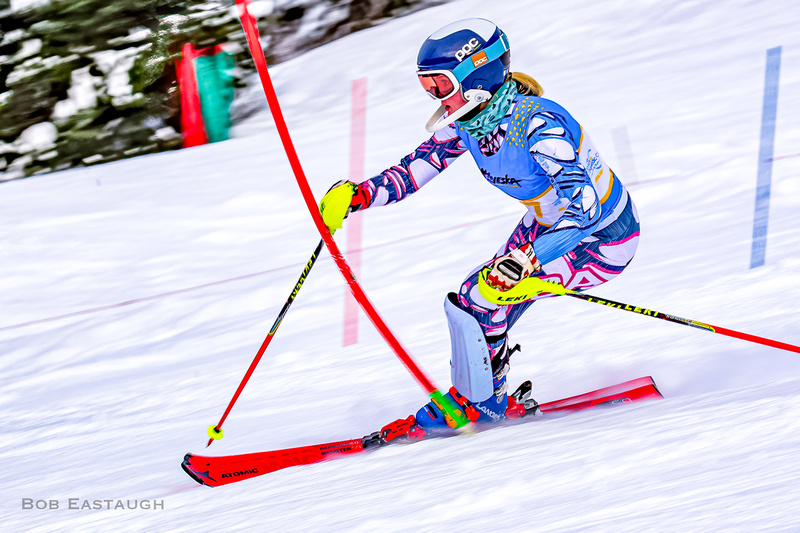

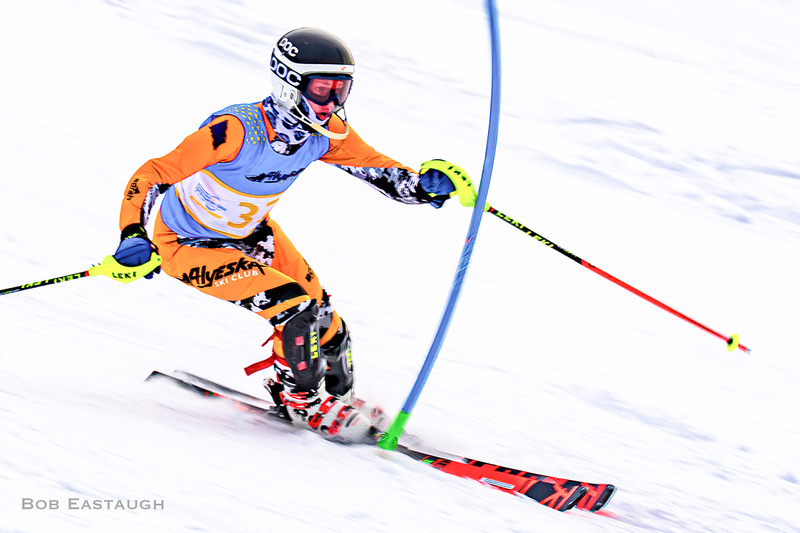





Panning is an art, and the difficulty increases when the photographer is standing on a slippery, sloped surface, i.e., a typical race hill, making it harder to pan and hold the camera steady. Even at 1/3200 or 1/4000 of a second shutter speeds, racers' micro-motion can be visible as blur (most obviously in the tips of slalom poles being cleared, but also in racers’ faces and eyes because their heads inevitably react to surface features and terrain.
And, despite panning’s potential for producing impressionistic color and graphics and conveying velocity and thus creating “artier” images, it is also unlikely to produce quality photos of racers’ eyes or to depict the precision of what they are doing.


Just to show what a really slow shutter speed can do, here is an example of a non-panned image, taken with a very, very slow shutter on a snowy morning on the race hill:


So, ignoring technical adventures, let’s talk about why I consider the next image my best race photo for the 2020-2021 race season:
First, the image, A9218038:


Alyeska Ski Club U16 Finnigan Donley is here running the straightest possible line through a three-gate flush. His center of mass is inside the corridor between the gates. This image, by the way, A9218038, is one frame later (I was using 14 frames-per-second and a 1/3,200th shutter speed) than A9218037, also of Finnigan.
Here is A9218037:
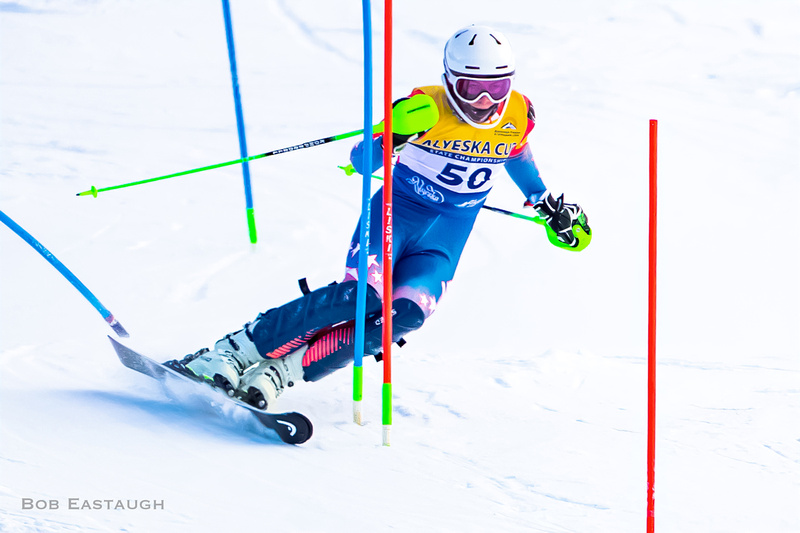

Now, the explanation:
A9218038 is my choice: it shows great action, serious drama (how long can someone ski on the outside edge of the inside ski in a narrow stance while his center of mass is easily 18-to-24 inches farther inside the only edge touching the snow, with the outside ski completely off the snow - try it sometime); it raises the sort of questions good photos raise (what happened next? did he fall? did he win?); it has nice graphics (good contrast between suit and snow, good bend on gate, and the blue gate is making a nice S-shape); it shows great race technique (simultaneous contact with the gate with both the handguard and the shinguard, and stacked position, equally edged skis, and a position impossible for anyone without remarkable skill). It is a technically good, but not a technically great, photo: it looks sharp, but wouldn't seem as sharp if it were enlarged to, say, 20x30 inches. I took lots (many thousands) of sharper race photos this season, but sharpness isn't everything. For me, the other strengths of the image significantly outweigh the imperfection of its minor unsharpness. There are a few nice details: his eyes are visible; there is a subtle spray of snow off the skis.
The equipment used on this shot was, for me, unusual. I had already photographed the first race, using my usual gear, but I came back to try using a very long lens set up (a 500 mm with a 1.4 extender, giving 700 mm effective length). I had to use a monopod because the combination was so heavy and hard to handhold.
The photo is, I think, better than the preceding frame, A9218037, largely because there the overlap of skis is distracting; some viewers might wonder if he is on a mono-ski. And the contact with the gate is less precise and the spray of snow is less interesting.
Here is my choice for runner-up this year: A9211881.
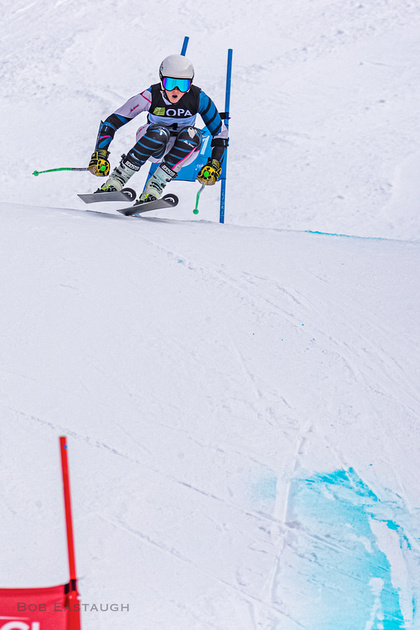

Randi von Wichman is a very skilled ASC U19. Here she skis over a roll that threw many racers in a FIS giant slalom as they came off the steep Steilhung pitch.
It is my runner-up because it is strong athletically, has good graphics, including the tracks carved by previous racers, and shows the racer and the roll and gate in context of the succeeding gate, as well as the face of the Steilhung pitch above. But I mainly like it for the emotion, because Randi shows some, but not too much, genuine surprise at being airborne. She is reacting nicely and will have plenty of space to carry speed into the next gate without forcing it. And the shot is nice and sharp.
So, that's it for the season, and that also ends my posts about the intersection between alpine racing and photography. Thanks for visiting. In the next weeks, I'll turn to posts on non-skiing topics, Maui in 2021, Denali National Park and Preserve, and Halibut Cove.
